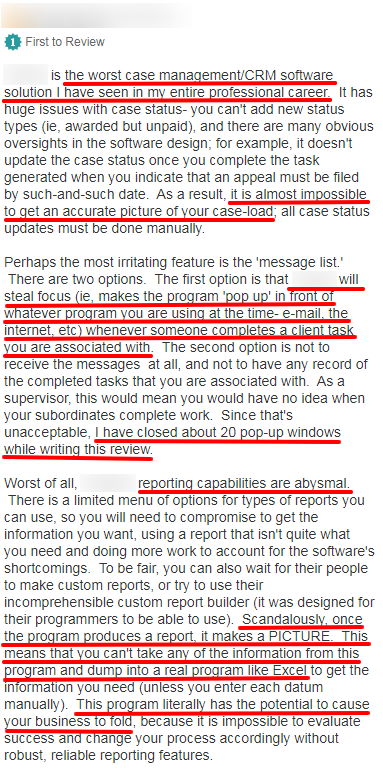Typically, when customers are in the market for a particular type of software, they compare features. Tools with the largest feature-set, best reviews and the lowest price typically win. However, approaching software with a “less is more mindset,” you can find the best legal practice management software that your firm needs to improve performance.
Why less is more with legal software
The vast majority of customers want more; it’s completely understandable. They’re focused on getting the most value for their money. They want a reliable provider who’s interested are aligned with their own. Features are a good indication of that, right?
It’s actually the opposite. Features and benefits are a fantastic way to sell software to customers on the front end, but it’s a surefire way to lose them on the back end.
There are a variety of unexpected factors law firms need to take into consideration. A large feature set exacerbates these problems, because they:
- Increase transitional pain due to the longer onboarding and training times needed to get up to speed
- Large features spread the ROI out across the features. You’re getting 20 percent of your results from 80 percent of the features. It should be the opposite.
- More features mean it’s harder for your timekeepers to learn, which means they’re less likely to use it. Timekeepers are forced into no-win scenarios. Hitting their billable hours for the month or learn to use the software you’ve paid for?
- If your timekeepers are focused on learning how to use all of the features in your software, they’re not producing billable work. That also means your utilization rates are poor.
All of this from a bloated features list. But most legal customers want a “robust feature list!” How can software providers and law firms get what they want?
Start with a core set of features
These are the important features that enable law firms to get their teams up and running in minutes. Time tracking, billing, invoices, calendaring.
The legal industry is complicated. A good software provider, like Bill4Time, will keep things simple, using conventions your timekeepers are already familiar with and work to minimize downsides. Here’s a simple list of dos and don’ts you can use as a guide.
Your software won’t:
- Complicate your work unnecessarily
- Decrease the ROI you’re supposed to receive from your firm
- Overcomplicate things for your employees or timekeepers, they’ll be able to jump in quickly
- Won’t keep your team from working on the details that matter (e.g., billable hours, tasks, events, invoicing, etc.)
Now let’s take a look again at a real-life example of software that makes these mistakes.

This customer review, and others like it, show that this particular software provider has made all four of these mistakes. How do we know this? Look at the quote at the bottom of their review.
“This program literally has the potential to cause your business to fold, because it is impossible to evaluate success and change your process accordingly without robust, reliable reporting features.”
Imagine being sold on a tool for your firm and experiencing this kind of outcome. Can you blame this law firm owner for being so upset?
The best legal practice management software minimizes your problems
Customers want more features. Legal software providers should give their customers more features – at the appropriate time. As a legal professional, you’ll want to focus your attention on providers who can do two things:
- Provide easy onboarding
- Minimize transitional pain and unnecessary confusion
It’s a counterintuitive approach, and it’s one the best practice management software providers use often. Search for a provider with a “less is more” approach. Test their claims out for yourself. You’ll find the best software providers are eager to show you what their tools can do for your firm.

Leave a Reply